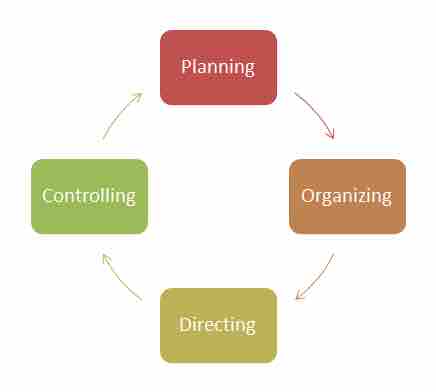Management and Organization
Management operates through various functions, often classified as planning, organizing, staffing, leading/directing, controlling/monitoring, and motivating. The organizing function creates the pattern of relationships among workers and makes optimal use of resources to enable the accomplishment of business plans and objectives.
The organizing function typically follows the planning stage. Specific organizing duties involve the assignment of tasks, the grouping of tasks into departments, and the assignment of authority and allocation of resources across the organization.

The management process
The management process involves tasks and goals of planning, organizing, directing, and controlling.
Structure
Structure is the framework in which the organization defines how tasks are divided, resources are deployed, and departments are coordinated. It is a set of formal tasks assigned to individuals and departments. Formal reporting relationships include lines of authority, decision responsibility, number of hierarchical levels, and span of managers' control. Structure is also the design of systems to ensure effective coordination of employees across departments.
Authority/Chain of Command
Authority is a manager's formal and legitimate right to make decisions, issue orders, and allocate resources to achieve desired outcomes for an organization. Responsibility is an employee's duty to perform assigned tasks or activities. Accountability means that those with authority and responsibility must report and justify task outcomes to those above them in the chain of command.
Through delegation, managers transfer authority and responsibility to their subordinates. Organizations today tend to encourage delegation from the highest to lowest possible levels. Delegation can improve flexibility to meet customers' needs and to adapt to competitive environments. Managers may find delegation difficult, since control over the task assigned (and eventual outcome) is relinquished.
One critical risk of command chains is micromanagement, where managers fail to delegate effectively and exercise excessive control over their subordinates' projects. Micromanagement reduces efficiency and limits autonomy, thus limiting the adaptability of a given organization. Effective chains of command must allow for flexibility and efficient delegation.
Types of Authority (and Responsibility)
- Line authority: Managers have the formal power to direct and control immediate subordinates executing specific tasks within a chain of command, usually within a specific department. The superior issues orders and is responsible for the result; the subordinate obeys and is responsible only for executing the order according to instructions.
- Functional authority: Managers have formal power over a specific subset of activities that include outside departments. For instance, a production manager may have the line authority to decide whether and when a new machine is needed, but a controller with functional authority requires that a capital expenditure proposal be submitted first, showing that the investment in a new machine will yield a minimum return. The legal department may also have functional authority to interfere in any activity that could have legal consequences. For example, a purchase contract for a new machine cannot be approved without a review of the machine's safety standards.
- Staff authority: Staff specialists manage operations in their areas of expertise. Staff authority is not real authority because a staff manager does not order or instruct but simply advises, recommends, and counsels in the staff specialists' area of expertise; the manager is responsible only for the quality of the advice (in line with the respective professional standards, etc.). Staff authority represents a communication relationship with management. It has an influence that derives indirectly from line authority at a higher level.
Organizational Structure and Control/Decision-Making
- Tall structure: A management structure characterized by an overall narrow span of management, a relatively large number of hierarchical levels, tight control, and reduced communication overhead. Decision-making can be quite rapid, if it occurs from the top down.
- Flat structure: A management structure characterized by a wide span of control and relatively few hierarchical levels, loose control, and ease of delegation. Decision-making is often slower, as it involves a high degree of integration across the company.
- Centralization: The location of decision making authority near top organizational levels. Similar to a tall structure, this expedites decision-making from the top down.
- Decentralization: The location of decision making authority is relatively evenly dispersed across the company. This works well when creativity and independent operations create value for the organization.
As each structure will create a different organizational approach to operations, it is critical to consider how the selection of a structure will affect the business process. Enabling creativity and minimizing control often comes at the cost of speed and efficiency, and vice versa.